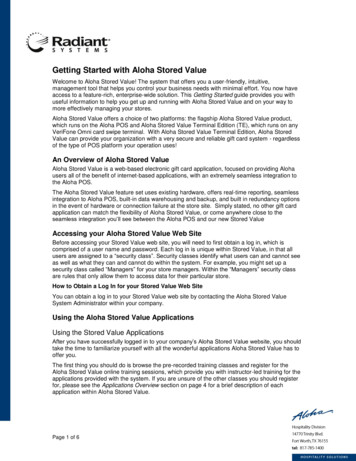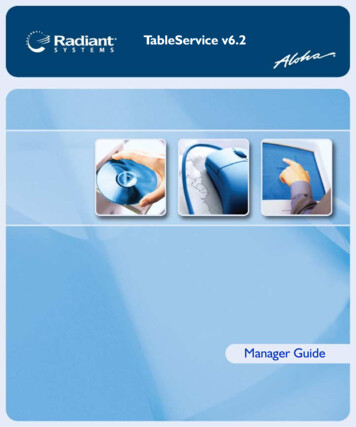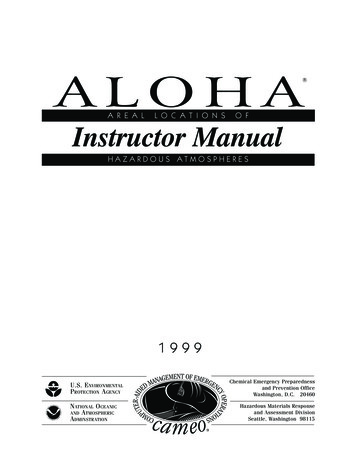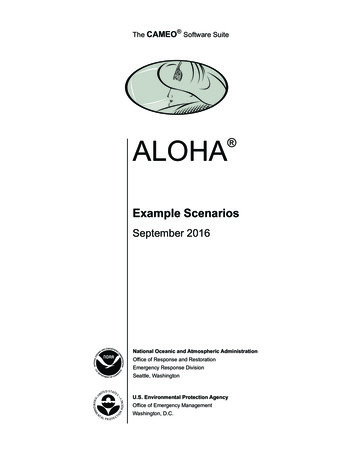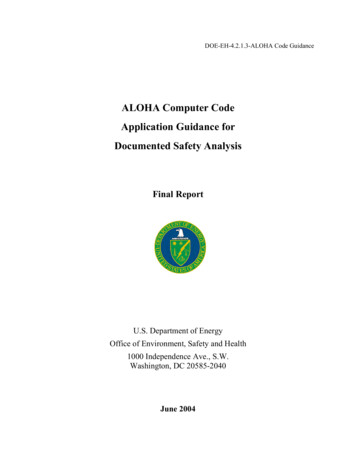
Transcription
DOE-EH-4.2.1.3-ALOHA Code GuidanceALOHA Computer CodeApplication Guidance forDocumented Safety AnalysisFinal ReportU.S. Department of EnergyOffice of Environment, Safety and Health1000 Independence Ave., S.W.Washington, DC 20585-2040June 2004
ALOHA Guidance ReportFinal ReportJune 2004INTENTIONALLY BLANKii
ALOHA Guidance ReportFinal ReportJune 2004FOREWORDThis document provides guidance to Department of Energy (DOE) facility analysts in the use ofthe ALOHA computer code for supporting Documented Safety Analysis applications.Information is provided herein that supplements information found in the ALOHAdocumentation provided by the code developer. ALOHA is one of six computer codesdesignated by DOE’s Office of Environmental, Safety and Health as a toolbox code for safetyanalysis.Suggestions for corrections or improvements to this document should be addressed to –Chip LagdonEH-31/GTNOffice of Quality Assurance ProgramsU.S. Department of EnergyWashington, D.C. 20585-2040Phone (301) 903-4218Email: Chip.Lagdon@hq.doe.goviii
ALOHA Guidance ReportFinal ReportJune 2004INTENTIONALLY BLANKiv
ALOHA Guidance ReportFinal ReportJune 2004REVISION STATUSPage/Section1. Entire Document2. Entire DocumentRevision1. Final Draft for Review2. Final ReportvChange1. Original Issue2. Updated all sections per reviewcomments.
ALOHA Guidance ReportFinal ReportJune 2004INTENTIONALLY BLANKvi
ALOHA Guidance ReportFinal ReportJune 2004TABLE OF CONTENTSSectionPageFOREWORD . IIIREVISION STATUS. VEXECUTIVE SUMMARY . ION . 1-1BACKGROUND: OVERVIEW OF TOOLBOX SOFTWARE IN CONTEXT OF 10 CFR 830 . 1-2SCOPE . 1-3PURPOSE . 1-3APPLICABILITY . 1-3SUMMARY DESCRIPTION OF THE ALOHA CODE . 2-1ALOHA CODE DEVELOPMENT . 2-1OVERVIEW OF ALOHA MODELS . 2-2ALOHA SOFTWARE QUALITY ASSURANCE . 2-5APPLICABLE REGIMES. 3-1OVERALL APPLICATION IN SAFETY ANALYSIS . 3-1PHENOMENOLOGICAL REGIMES OF APPLICABILITY . 3-2INPUTS AND RECOMMENDATIONS . 4-14.1OVERVIEW OF ALOHA INPUT MENUS . 4-14.2INPUT RECOMMENDATIONS FOR SITE DATA PARAMETERS. 4-24.2.1Location . 4-24.2.2Building Type . 4-24.2.3Date and Time. 4-34.3INPUT RECOMMENDATIONS FOR SET UP PARAMETERS (SCENARIO DEFINITION) . 4-34.3.1Chemical Information . 4-34.3.2Atmospheric Options . 4-54.3.3Source . 4-164.3.4Computational Preferences . 4-354.4INPUT RECOMMENDATIONS FOR DISPLAY PARAMETERS . 4-365.0SPECIAL CONDITIONS FOR USE . 5-16.0SOFTWARE LIMITATIONS . 6-16.16.2ALOHA ISSUES . 6-1OUTCOME OF GAP ANALYSIS . 6-67.0SAMPLE CALCULATIONS: PUDDLE EVAPORATION. 7-18.0ACRONYMS & DEFINITIONS. 8-19.0REFERENCES . 9-1vii
ALOHA Guidance ReportFinal ReportJune 2004APPENDIX A: ATMOSPHERIC TRANSPORT AND DISPERSION MODELS . A-1Neutrally Buoyant Model . A-1Dense Gas Model. A-7APPENDIX B: TORNADO DILUTION FACTOR. B-1APPENDIX C: DEVELOPMENTAL HISTORY OF ALOHA. C-1viii
ALOHA Guidance ReportFinal ReportJune 2004TABLE OF TABLESTablePageTable 4-1 Use of Chemical Property Data. 4-5Table 6-1 ALOHA Limitations. 6-1ix
ALOHA Guidance ReportFinal ReportJune 2004TABLE OF FIGURESFigurePageFigure 2-1. ALOHA Graphical Output. 2-5Figure 4-1. ALOHA Menu Bar. 4-1Figure 4-2. Sample ALOHA Dialog Box for Data Entry. . 4-2Figure 4-3. Heat Transfer Mechanisms with Puddle Source Configuration. 4-22Figure B-1. The maximum time-integrated ground-level centerline air concentration (s/m3)versus downwind distance (km) for different mean translational speeds from 7.5m/s to 22.5m/s. The downdraft speed is 10 m/s and the height of the cylindrical mesocyclone is 3500m (from Weber and Hunter, 1996). . B-2x
ALOHA Guidance ReportFinal ReportJune 2004ALOHA Computer Code Application Guidance for Support ofDocumented Safety AnalysisEXECUTIVE SUMMARYThe Defense Nuclear Facilities Safety Board issued Recommendation 2002-1 on QualityAssurance for Safety-Related Software in September 2002. The Recommendation identified anumber of quality assurance issues for software used in the Department of Energy (DOE)facilities for analyzing hazards, and designing and operating controls that prevent or mitigatepotential accidents. The development and maintenance of a collection, or “toolbox,” of high-use,Software Quality Assurance (SQA)-compliant safety analysis codes is one of the majorcommitments contained in Implementation Plan for Recommendation 2002-1 on QualityAssurance for Safety Software at Department of Energy Nuclear Facilities. In time, the DOEsafety analysis toolbox will contain a set of appropriately quality-assured, configurationcontrolled, safety analysis codes, managed and maintained for DOE-broad safety basisapplications (DOE, 2002b). The Areal Locations of Hazardous Atmospheres (ALOHA) code isone of the designated toolbox codes.ALOHA may require some degree of quality assurance improvement before meeting currentSQA standards. In the interim period before these changes are completed, ALOHA is stillconsidered a useful asset in the support of safety basis calculations. To ensure appropriateapplication of the designated toolbox software, the Implementation Plan has committed tosponsoring a set of code-specific documents to guide informed use of the software, andsupplement the available user’s manual information.The ALOHA guidance report includes the following: Applicability information for DSA-type analysis, specifically tailored for DOE safetyanalysis Code development information and SQA background Appropriate regimes and code limitations Valid ranges of input parameters consistent with code capability and DOE safety basisapplications, and Default input value recommendations for site-independent parameters.Use of the information contained here, although not ensuring correct use of ALOHA in eachanalytical context, will minimize potential user errors and the likelihood of ALOHA use outsideits regime of applicability.xi
ALOHA Guidance ReportFinal ReportJune 2004INTENTIONALLY BLANKxii
ALOHA Guidance ReportFinal Report1.0June 2004INTRODUCTIONIn January 2000, the Defense Nuclear Facilities Safety Board (DNFSB) issued Technical Report25, (TECH-25), Quality Assurance for Safety-Related Software at Department of EnergyDefense Nuclear Facilities (DNFSB, 2000). TECH-25 identified issues regarding the state ofsoftware quality assurance (SQA) in the Department of Energy (DOE) Complex for softwareused to make safety analysis decisions and to control safety-related systems. Instances werenoted in which computer codes were either inappropriately applied or were executed withincorrect input data. Of particular concern were inconsistencies in the exercise of SQA from siteto site, and from facility to facility, and the variability in guidance and training in the appropriateuse of accident analysis software.During the subsequent 2000 to 2002 period, survey information on SQA programs, processes,and procedures was collected as well as the initial elements to a response plan. However, toexpedite implementation of corrective actions in this area, the DNFSB issued Recommendation2002-1, Quality Assurance for Safety-Related Software at Department of Energy DefenseNuclear Facilities (DNFSB, 2002). As part of its recommendation to the DOE, the DNFSBenumerated many of the points noted earlier in TECH-25, but noted specific concerns regardingthe quality of the software used to analyze and guide safety-related decisions, the quality of thesoftware used to design or develop safety-related controls, and the proficiency of personnel usingthe software.DOE has developed a series of actions that address the Board’s concerns, contained in theImplementation Plan for the DNFSB Recommendation, Implementation Plan for DefenseNuclear Facilities Safety Board Recommendation 2002-1. Two of the actions include:(i) identification of a suite of accident analysis software that is widely used in the DOEComplex, and(ii) issuance of code-specific guidance reports on the use of the “toolbox” codes for DOE facilityaccident analysis, identifying applicable regime in accident analysis, default inputs, andspecial conditions for use.Safety analysis software for the DOE “toolbox” status was designated by the DOE Office ofEnvironment, Safety and Health (DOE/EH, 2003). The supporting basis for this designation wasprovided by a DOE-chartered Safety Analysis Software Group in a technical report entitled,Selection of Computer Codes for DOE Safety Analysis ve/rec/2002-1/NNSACCodes1.pdf), and includes version 5.2.3 ofthe Areal Locations of Hazardous Atmospheres (ALOHA) code.It is believed that each code designated for the toolbox can be applied to accident analysis underthe precautions and recommended input parameter ranges documented in the body of this report.This code-specific document will be maintained and updated until a minimum qualificationsoftware package is completed.The contents of this report are applicable in the interim period until measures are completed to1-1
ALOHA Guidance ReportFinal ReportJune 2004bring ALOHA into compliance with defined SQA standards. The primary objective of theguidance report is to provide information on the use of ALOHA for supporting DOE safety basisaccident analysis. Specifically, the report contains: Applicability guidance for Documented Safety Analysis (DSA)-type analysis,specifically tailored for DOE safety analysis Appropriate regimes, recommended configurations Overcoming known vulnerabilities and avoiding code errors Valid ranges of input parameters consistent with code capability and DOE safety basisapplications Default input value recommendations for site-independent parameters, and Citations of currently available SQA documentation.Thus, this report is intended to complement existing ALOHA user’s documentation. The lattertends to be much broader in coverage of the full range of capabilities of ALOHA and thespectrum of inputs that might be needed depending upon the application, but lack cohesive andtargeted guidance for particular applications such as DSA accident analyses. Furthermore, thegoal of this document is to identify limitations and vulnerabilities not readily found indocumentation from the code developer or published elsewhere.The ALOHA guidance document is written using the following set of sections. The first sectioncontains an introduction and background providing an overview of toolbox software in thecontext of 10 CFR 830 (CFR, 2001). More information follows on the scope and purpose of thisdocument. The next major section is a summary description of ALOHA. A third sectiondiscusses applicable regimes for using ALOHA in performing accident analysis. A large sectionon default inputs and recommendations, emphasizing appropriate inputs for DOE applications,succeeds this section. Following this discussion are sections on special conditions for use of thesoftware and software limitations. A sample case is then provided, followed by acronyms anddefinitions, references, and appendices.1.1Background: Overview of Toolbox Software in Context of 10 CFR 830In the context of 10 CFR 830, the Nuclear Safety Management rule, the six computer codesdesignated by DOE/EH as toolbox software will be of appropriate pedigree for support of safetybasis documentation. After completion of the minimum required SQA upgrade measures for atoolbox code, the safety analyst would still need to justify the specific application with the codeof interest, input parameters, and user assumptions, but many SQA burdens would be reducedfrom current requirements. The user would need to reference the toolbox code and version,identify compliance with their organization’s SQA requirements and demonstrate that the code isbeing applied in the proper accident analysis context using appropriate inputs. The SQApedigree would be sufficiently established for technical review purposes since the code isrecognized as toolbox-supported.1-2
ALOHA Guidance ReportFinal ReportJune 2004Only six codes out of more than one hundred software packages applied in the DOE Complex foraccident analysis purpose have been designated as “toolbox” codes (DOE, 2002b). Other nontoolbox, dispersion and consequence software can still be applied in the context of support safetybasis applications. However, each organization applying this category of software will need todemonstrate compliance with applicable SQA criteria, such as those applied to the toolboxsoftware.1.2ScopeThe ALOHA guidance report includes the following: Applicability information for DSA-type analysis, specifically tailored for DOE safetyanalysis Code development information and SQA background Appropriate regimes and code limitations Valid ranges of input parameters consistent with code capability and DOE safety basisapplications, and Default input value recommendations for site-independent parameters.1.3PurposeThe ALOHA code, while part of the toolbox collection of software, still may require SQAupgrades prior to meeting current established standards for software. However, until these SQAupgrades are completed so that ALOHA meets current established standards for software,ALOHA can be applied safely by following the guidance contained in this report. Once SQAupgrades are finalized with ALOHA, it will be brought under configuration control and placed inthe toolbox.Use of the information contained here, although not ensuring correct use of ALOHA in allanalytical contexts, will minimize potential user errors and the likelihood of use outside regimesof applicability.1.4ApplicabilityEven though ALOHA was developed as a tool for emergency response and emergencypreparedness/planning, it is also widely used throughout the DOE complex to support 10 CFR830 safety analysis. Note that this guidance document does not specifically address applicationissues related to emergency response or emergency preparedness/planning.It is recognized that other computer codes besides ALOHA exist that perform similar sourceterm and downwind concentration calculations. Moreover, manual or electronic spreadsheetcalculations can be a viable alternative to using a computer code for many accident analysis1-3
ALOHA Guidance ReportFinal ReportJune 2004applications that involve chemical spills. The relative merits of using a different computerprogram or using a hand calculation for a given application is a judgment that must be made bythe analyst on a case-by-case basis.The U.S. Department of Energy (DOE) has provided guidance and general recommendations inthis area through the Accident Phenomenology and Consequence (APAC) MethodologyEvaluation Program. As part of this program, the Chemical Dispersion and ConsequenceAssessment (CDCA) Working Group (WG) was established to address issues and evaluatemethodologies in the CDCA domain. Other WGs were also established for other domains ofsafety analysis (i.e., fire analysis, explosion analysis, spill source term analysis, in-facilitytransport analysis, and radiological dispersion and consequence assessment). The CDCA WG(also referred to as WG 6) issued a report that identifies and evaluates methodologies andcomputer codes to support CDCA applications (Lazaro, 1997). Also of interest is the WG 3report, which performed a similar function for source term analysis of spills (Brereton, 1997).The CDCA WG 6 report identified the ALOHA computer code as a recommended code that is“applicable to generally broad safety basis documentation applications.” The ALOHA code wassimilarly recommended by the Spills WG 3 report. In addition to code recommendations, boththe Spills WG 3 report and the CDCA WG 6 report also provide a broad set of recommended“best practices” for modeling chemical releases to the atmosphere for safety analysisapplications.This report builds upon the WG 3 and WG 6 work to provide guidance and recommendationsthat are targeted to the use of the ALOHA code to calculate source terms and downwindconcentrations for safety analysis applications.1-4
ALOHA Guidance ReportFinal Report2.0June 2004SUMMARY DESCRIPTION OF THE ALOHA CODEThis section provides a summary form description of the ALOHA. A brief overview is givenwith additional information to follow in other sections and appendices of the report to providemore in-depth coverage of topics such as the principles of source term development for analysisof accidents that involve chemical inventories, the interface with dispersion conditions in theatmosphere, and the overall assessment of toxicological exposure to receptors.2.1ALOHA Code DevelopmentThe current version (as of January 2004) of the ALOHA code is version 5.2.3, was released in1999.1 ALOHA is a public domain code that is part of a system of software that is known as theComputer-Aided Management of Emergency Operations (CAMEO) that was developed to planfor and respond to chemical emergencies. It is also widely used throughout the DOE complexfor safety analysis applications, which is the focus of this document. The United StatesEnvironmental Protection Agency (EPA), through its Chemical Emergency Preparedness andPrevention Office (CEPPO), and the National Oceanic and Atmospheric Administration(NOAA) Office of Response and Restoration jointly sponsor ALOHA. ALOHA can bedownloaded free of charge from the EPA website (http://www.epa.gov/ceppo/cameo/aloha.htm).An accompanying user’s manual can also be obtained at the website (NOAA, 1999a). An onlinehelp is also built into the code and a technical staff is available to address user questions (NOAA,1999b).The ALOHA code has evolved over the years to add capabilities, improve algorithms, andcorrect errors. Appendix C contains a reproduction of website information on the developmentalhistory of the ALOHA code from the early 1980s to the o/alohafaq/history.html).ALOHA runs either on Macintosh or in Microsoft WindowsTM (version 95 or later) on IBMcompatible personal computers. ALOHA requires a least 1 megabyte (MB) of RAM and about2.5 MB of hard disk space.Information sources for the technical details of the ALOHA algorithms are from the ALOHAUser’s manual (NOAA, 1999a), the online help with ALOHA 5.2.3 (NOAA, 1999b), the APACWG reports (Brereton, 1997; Lazaro, 1997), a NOAA report (Evans, 1993) and a draft NOAAtheoretical description memorandum (for ALOHA 5.0) (Reynolds, 1992). Information fromALOHA websites is also used: http://www.epa.gov/ceppo/cameo/instruct.htm tml 1A new version of ALOHA, namely ALOHA 5.3, was released in March 2004 just priorto the issuance of this report.2-1
ALOHA Guidance ReportFinal Report June ha.htmlWhenever possible, an attempt was made to verify any information that was in the draft NOAAtheoretical description memorandum through use of the others sources of information.2.2Overview of ALOHA ModelsALOHA performs calculations for chemical source terms and resulting downwindconcentrations. Source term calculations determine the rate at which the chemical material isreleased to the atmosphere, release duration, and the physical form of the chemical upon release.2The term cloud is used in this document to refer to the volume that encompasses the chemicalemission. In general, the released chemical may be a gas, a vapor, or an aerosol. The aerosolrelease may consist of either solid (e.g., fume, dust) or liquid (e.g., fog, mist, spray) particles thatare suspended in a gas or vapor medium. 3 Liquid particles are also referred to as droplets.The analyst specifies the chemical and then characterizes the initial boundary conditions of thechemical with respect to the environment through the source configuration input. The ALOHAcode allows for the source to be defined in one of four ways (i.e., direct source, puddle source,tank source, or pipe source) in order to model various accident scenarios. The sourceconfiguration input is used to either specify the chemical source term or to provide ALOHA withthe necessary information and data to calculate transient chemical release rates and physical stateof the chemical upon release. ALOHA calculates time-dependent release rates for up to 150 timesteps (NOAA, 1999a). ALOHA then averages the release rates from the individual time stepsover one to five averaging periods, each lasting at least one minute (NOAA, 1999a). The fiveaveraging periods are selected to most accurately portray the peak emissions. The five averagerelease rates are inputs to the ALOHA algorithms for atmospheric transport and dispersion(NOAA, 1999a). ALOHA tracks the evolution of the mean concentration field of the five2More sophisticated source term algorithms found in some other computer codes will also model theenergetic effects of the release (e.g., as would occur with a fire or explosion) to include the impact of theinitial momentum and buoyancy. ALOHA ignores these effects that can lead to initial puff or plume rise,which is sometimes modeled through an effective, elevated release height. The ALOHA approach ofignoring initial puff or plume rise is conservative in accident analysis applications since the ground-levelconcentration will be less with an elevated release with respect to a ground-level release when plumedepletion from deposition effects are ignored, as is done in ALOHA.3The ALOHA code user’s manual cautions that the ALOHA code does not model particulate transportphenomena (e.g., gravitational settling). Generally, particulate transport phenomena can be ignored withlittle error, but it is up to the analyst to make a determination of whether a passive atmospheric transportor dense-gas transport model is most appropriate. ALOHA has both models, and information in thisdocument will provide guidance on their use. In the case of low concentrations of very fine airborneparticles, it is reasonable to neglect transport phenomena peculiar to particulate and to assume that theparticles remain suspended and act as a passive scalar contaminant that follows the flow field (Hanna,2002). Under high concentrations of particles, the density of the cloud may be high enough that dense gastransport phenomena may be important.2-2
ALOHA Guidance ReportFinal ReportJune 2004separate chemical clouds and calculates the concentration at a given time and location throughsuperimposition. ALOHA limits releases to one hour.Evolution of the mean concentration field of the chemical cloud is calculated through algorithmsthat model turbulent flow phenomena of the atmosphere. The prevailing wind flows andassociated atmospheric turbulence serve to transport, disperse4, and dilute the chemical cloudthat initially forms at the source. For an instantaneous release or release of short duration, thechemical cloud will travel downwind as a puff. In contrast, a plume will form for a sustained orcontinuous release.The wind velocity is a vector term defined by a direction and magnitude (i.e., wind speed). Thewind direction and wind speed determine where the puff or plume will go and how long it willtake to reach a given downwind location. For sustained or continuous releases, the wind speedhas the additional effect of stretching out the plume and establishing the initial dilution of theplume (i.e., determines the relative proportion of ambient air that initially mixes with thechemical source emission). Atmospheric turbulence causes the puff or plume to increasinglymix with ambient air and grow (disperse) in the lateral and vertical direction as it travelsdownwind. Longitudinal expansion also occurs for a puff. These dispersion effects furtherenhance the dilution of the puff or plume. The two sources of atmospheric turbulence aremechanical turbulence and buoyant turbulence. Mechanical turbulence is generated from shearforces that result when adjacent parcels of air move at different velocities (i.e., either at differentspeeds or directions)5. Fixed objects on the ground such as trees or buildings increase the groundroughness and enhance mechanical turbulence in proportion to their size. Buoyant turbulencearises from vertical convection and is greatly enhanced by the formation of thermal updrafts thatare generated from solar heating of the ground.The ALOHA code considers two classes of atmospheric transport and dispersion based upon theassumed interaction of the released cloud with the atmospheric wind flow. For airborne releases in which the initial chemical cloud density is less than or equal to thatof the ambient air, ALOHA treats the released chemical as neutrally buoyant.6 A neutrally4The term dispersion is sometimes used in the literature to describe the combined effects of advection(transport by the bulk motion of the wind flow) and turbulent diffusion (spreading) and other times,particularly in meteorological publications, to describe only the turbulent diffusion component. Thelatter, narrower sense is used in this document.5Atmospheric flows experience a change in speed with height due to the friction of the earth’s surface inslowing down the wind adjacent to it.6In the strictest sense, neutrally buoyant conditions exist when the density difference between thereleased chemical cloud and ambient air is small. A positively buoyant cloud is produced when the clouddensity is significantly less than that of the ambient air. The positive buoyancy induces puff or plume risethat results in an effective elevated release. The ALOHA code does not account for these positivebuoyancy effects, but instead models the release as neutrally buoyant. This approach is conservative inaccident analysis applications since the ground-level concentration will be less with an elevated releasewith respect to a ground-level release.2-3
ALOHA Guidance ReportFinal ReportJune 2004buoyant chemical cloud that is released to the atmosphere does not alter the atmosphericwind flow, and therefore, the term passive is used to describe the phenomenologicalcharacteristics associated with its atmospheric transport and dispersion. As a passivecontaminant, the released chemical follows the bulk movements and behavior of theatmospheric wind flow. Conversely, if the density of the initial chemical cloud is greater than that of the ambient air,then the possibility exists for either neutrally buoyant or dense-gas type of atmospherictransport and dispersion.7 In dense-
ALOHA Guidance Report June 2004 Final Report 1-2 bring ALOHA into compliance with defined SQA standards. The primary objective of the guidance report is to provide information on the use of ALOHA for supporting DOE safety basis accident analysis. Specifically, the report contains:

